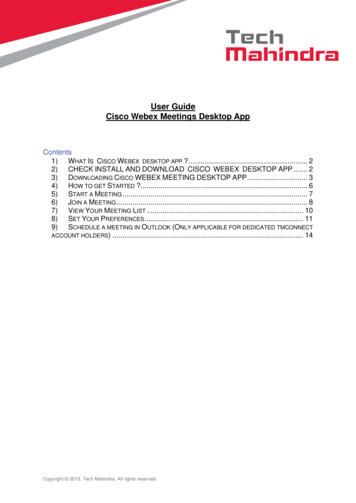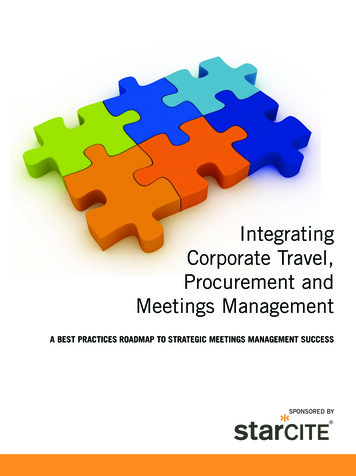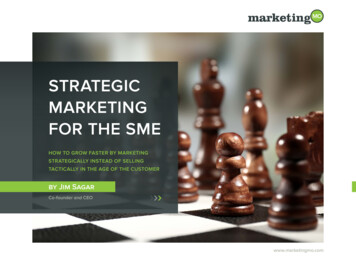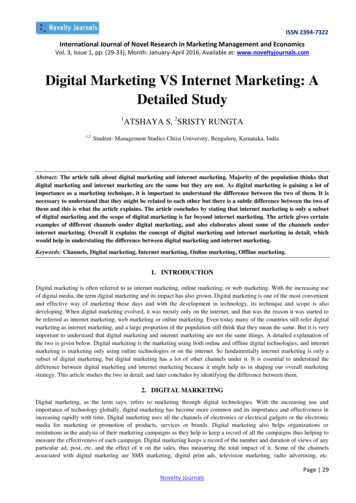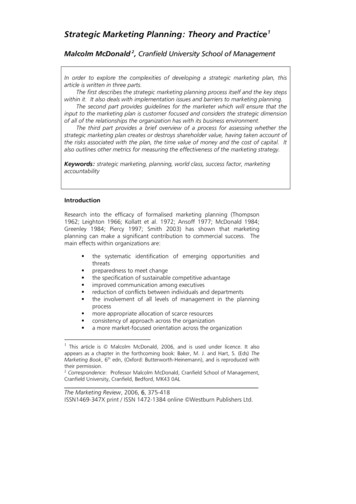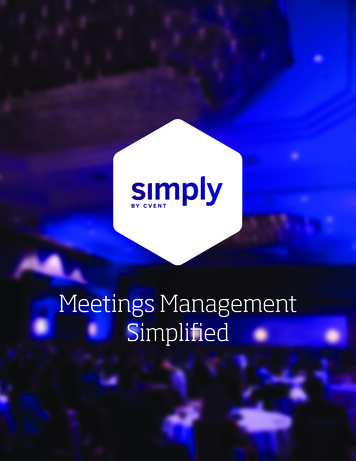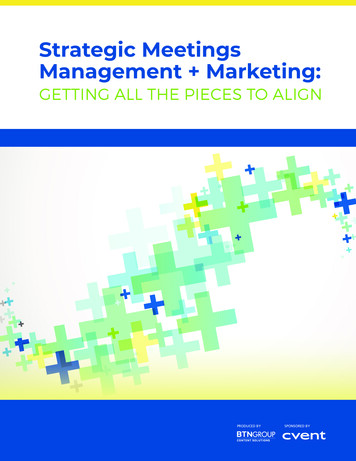
Transcription
Strategic MeetingsManagement Marketing:GETTING ALL THE PIECES TO ALIGNPRODUCED BY1SPONSORED BY
STRATEGIC MEETINGS MANAGEMENT MARKETING: GETTING ALL THE PIECES TO ALIGNWhile strategic meetings management programstypically roll out in corporations to improveprocurement and savings, often they operate outsidemarketing. A recent study conducted by Cvent on SMM programand marketing best practices found that while 80 percent oftravel managers/SMM program leaders said it’s “very valuable”to collaborate with marketing, less than 50 percent said theyoften work with marketing. A closer look at the goals of SMMand marketing can reveal more commonality than differences.Whether such teams should operate under the same umbrella, orsimply align processes and practices, there are benefits to gain, ashighlighted in this white paper. But stakeholders must understandthe goals, language and overall objectives of both functions.Why SMM is ImportantIt adds value to the business. An SMM Program, designed with several businessleaders, will impact the company’s goals of improved revenue, education, motivationHear meeting and event and marketingprofessionals discuss ways that SMM andMarketing should align on a webinaraccessible through Sept. 18, 2020, athttp://bit.ly/SMMandMarketing.and communication. Driving factors are often cost savings, leveraging spending, visibilityto total spend, risk mitigation, consistency and efficiency. The face-to-face channel isa critical component to a multi-pronged marketing strategy, which also may includewebinars, social media, advertising, training, etc.It increases the value for meeting stakeholders and participants. Theseare two key performance indicators to measure a meeting’s impact, sometimes knownas the return on investment (ROI), return on objective (ROO), or return on engagement(ROE). An SMM program can measure and report on all these drivers consistentlyacross meeting types. When SMM works to increase registrations and attendance atevents, that works to reduce the marketing cost per attendee ratios.It improves service and operations. There is significant duplication of effortacross meeting types, divisions and regions. Successful meetings managementstreamlines workflows and prioritizes the end-user experience.It generates savings and reinvestment opportunities. Even a rudimentarySMM process can reduce costs by as much as 20 percent. Many companies calculatesavings as a reduction to bottom-line budgets while some reinvest or optimize spend.It allows planner stakeholders to focus on content. Delivering a quality meetingwith the right branding and content in the right environment and without distractions frommishandled or arduous logistics contributes to individual meeting ROI. A fully establishedmeetings management program may also integrate with training, HR and customerrelationship management initiatives to track longer-term outcomes for meetings ROI.2
STRATEGIC MEETINGS MANAGEMENT MARKETING: GETTING ALL THE PIECES TO ALIGN80%Meetings management will reduce risk exposure in five areas.1. Contractual/legal/regulatory: Meetings management provides the pre-eventtravel managers/SMM programleaders who feel it is veryvaluable to collaborate withmarketing departments.visibility needed to ensure compliance.2. Financial: Use results-based financial data on meetings and events spend, volume and50%travel managers/SMM programleaders who work often withmarketing departments.It helps reduce overall risk to the organization.impact to drive decisions on the company’s omnichannel and multichannel goals.3. Business operations: Develop efficient and cost-effective operational plans tosupport meetings, conferences and events.4. Reputational: Ensure integrity- based sourcing and planning for meetings andevents to avoid poor public perception.5. Market: Ensure that participant experiences are exceptional and the time spent wasvaluable to them and aligned with corporate goals, mission and vision.Why Marketing Should Be Part of SMMWhat’s in it for marketing: A marketing team is interested in more touch pointsand interactions to drive messaging, leads, revenue and customer satisfaction. SMMprograms can help via standardized processes and automation, workflow and visibility,efficiency, negotiating venue contracts, payments and budget reconciliation, virtualmeetings, innovative apps and, most important, showing the return on engagement—particularly in the area of face-to-face events.“Event success is defined by ROMI or the return on marketing investment,” saidKimberly Scott, senior regional marketing manager for Illumina, on a recent BTNGroup webinar sponsored by Cvent. “That is how your marketing colleagues willmeasure their success.” A 2018 Oxford Economics and Events Industry Councilstudy, she added, found that 325 billion in direct spend on meetings in the UnitedStates generated 845 billion in sales. “To a marketeer, those events generated 2.6times ROMI—which is a really great number.”Meetings terms might need to be converted to marketing terms. “When we ledwith SMM and sourcing, the marketing team wouldn’t even talk to us,” saidAmanda Young, Global Event Operations—Strategy Leader, General Electric. “Butwhen we led with the end result—how this would help them achieve their objectives, they paid attention.”Marketing and SMM goals are “really all about helping a business achieve it’sgoals,” said Julie Haddix, director of Enterprise Marketing for Cvent. Key is learninghow to translate those terms into the language or metrics that all understand. And,added Scott, it is critical that teams define terms across all stakeholders in an organization. “Definitions are really important as how each department or individualdefines terms can be very different.”According to Kari Wendel, vice president, Strategic Customer Organization, CWTMeetings & Events, marketing historically pushed back harder as procurement gotmore involved. Recently, “I’m definitely seeing across our client base that marketingevents—and the marketing departments—are seeing the value,” she said. “SMM3
STRATEGIC MEETINGS MANAGEMENT MARKETING: GETTING ALL THE PIECES TO ALIGN“When marketingbecomes a trueconstituent in anSMM program, thebar moves higher forservice excellence andfor more advancedmeeting professionalsto really meet theneeds of thosemarketing teams,” saysKari Wendell, of CWTMeetings and Events.programs have generated a good internal track record and high credibility. I’ve seenmarketing departments come voluntarily to the discussion, saying, ‘Okay, there arewhole lot of pieces, transactionally and logistically, of our meetings that we wouldlove to not have to do so we can focus more on content and the right delivery.’”What’s in it for planning departments: From product launches and largesales meetings to regional training sessions, marketing divisions hold both high- andlow-profile meetings. Higher-profile events may be fully or partially outsourced to thirdparties and may be among the best managed meetings in the company. In addition tolooking for ways to leverage meetings spend with these events, planning departmentscan review their planning processes policies for best practices. “When marketingbecomes a true constituent in an SMM program, the bar moves higher for serviceexcellence and for more advanced meeting professionals to really meet the needs ofthose marketing teams,” says Wendell. Acknowledging what each has to offer theother will ease SMM buy-in for these two teams or departments.That has been the case at Autodesk, according to Gigi Gleason, senior manager, GlobalStrategic Meetings, Workplace & Travel. The five-year SMM program journey startedwith small meetings. As the team, process and technology proved value to stakeholders, the responsibilities expanded to not only small and midsize meetings but regionalcustomer events in North America, EMEA and APAC, 1,000-person user conferences,sales kickoffs and regional meetings, and incentive programs.The Value of DataAutodesk’s SMM team worked hard to understand stakeholder needs for each meetingand create a reliable process that could scale. A project to identify the best locales to hold“premier meetings, to bring those events closer to customers,” Gleason said, required adeep dive on all customer and meeting data over two years.Meetings management technology creates a central data repository for meetingsactivities that not only standardizes work-flow, but gathers data useful to both marketingand planning departments. Tech providers are working on end-to-end solutions thatcan accommodate both simple, self-service meetings and ultra large and complex userconferences and citywide conventions. These planning tools and apps enhance andextend the participant experience to span the pre-event, on-site and post-event periods.Newer meeting technology tools, whether for mobile, onsite attendee managementor other data capture tools, provide event managers with the ability to analyze andstrategize based on that data, according to consultants and event managers. Eventmanagers today are using data to inform decisions on food and beverage, agendasand break/meal times and amounts, and room layouts like never before. Beyond basiclead retrieval, sophisticated technology can provider marketers and SMM with precisedetails on attendee movement within a conference or exhibition and provide valuableinsights to help justify changes for future events, better leverage on new contracts andbuild the ROI, ROE or ROMI of your event.Data from mobile apps has grown in importance, especially regarding attendeeengagement and direct, real-time feedback. Some companies integrate meetings4
STRATEGIC MEETINGS MANAGEMENT MARKETING: GETTING ALL THE PIECES TO ALIGNtools, particularly meetings apps, with customer relationship management tools totrack follow-up from client-facing events and longer-term business opportunities andconversions to better quantify ROI. Increasingly, meeting tech is also integrated withleading marketing platforms so data can seemlessly flow without manual entries.Virtual/digital technology options such as webinars, real-time and perpetual-collaborationtechnologies that fit into today’s virtual and hybrid meeting delivery approach are othersources of attendee engagement that can generate useful data. “A couple of years ago,I did a study with a financial services client, using a [mobile] meetings app,” noted DebiScholar, SMM coach and global category lead-travel, for Teva Pharmaceuticals.“Over the course of several months, we were able to identify the clients whoparticipated in one meeting or multiple meetings, who downloaded availablepresentations, etc. What we found was that [the ones who participated more] actuallyproduced more revenue for the company. That’s the type of data that we want to get,”Scholar said. “You want to bring all your marketing tools together. You can find outwhen were they in the room, when were they on a virtual meeting, whatever deliverymethod we choose, how are they getting the content, how many meetings did they goto or shows did they go to. Then, how can you use that data to show if they attendedonce, if they attended twice, if they attended three times; how much did they interactwithin the meeting app; how many documents did they download. Then, as a result,did they actually buy something? That really shows not only the return on investmentbut also return on engagement.”Common marketing questions companies want to answer with data:1. S ales or Revenue generation: Did you sell more as a result of that event? Did theattendees who were more engaged at the event buy more from a company?2. Lead generation: How many new leads were produced? How many existing leads werenurtured along a sales path? How much did it cost to acquire or nurture those leads?3. Raising brand awareness: Was the brand effective in building brand perception?“You can start to look at analytics around social media and around Instagram postsrelated to your brand, around activation and [if they] actually shared it on socialmedia with followers.”4. Attendee Engagement and/or Satisfaction: How engaged were attendees inattending sessions, meeting with partners or attending events? How satisfied arethey, from survey results, Net Promoter Scores or other metrics your team deems arebest to identify desired objectives?5. Learning: Did attendees learn what we were trying to teach them? You candetermine this by “scoring them, testing them, checking their knowledge.”6. Networking: Did people connect at the event? “How many LinkedIn connections weremade from people in that room? Did people make connections that led to new business?”5
STRATEGIC MEETINGS MANAGEMENT MARKETING: GETTING ALL THE PIECES TO ALIGNConclusion and Next StepsDetermining whether or not to merge, or just more closely align marketing and SMM isa decision best informed by a detailed assessment of the benefits to one’s organization.But perhaps the two most important reasons are:1. An SMM program will take over many of the logistical, contractual, risk mitigation and duty of care responsibilities of planning and event, thus giving marketingstakeholders more time to focus on creating compelling content and brandingexperiences.2. Data generated from SMM processes and technology can greatly enrich marketingdatabases and help to lower marketing costs per registrant or attendee.3. New technologies and apps are making it possible to measure the experiential returnon investment, return on engagement and return on objective of marketing events.Data that can be aggregated when SMM and marketing are aligned could include:Pre Event: Audience segmentation, registration status/data, surveys, custom questionsand session enrollmentDuring Event: Check-in, session attendance, session feedback, poll responses, socialposts, speaker ratings, session ratings, booth visits, trade show scans, product demos,one-to-one appointments and activationsPost Event: attendee satisfaction scores, survey responses, attendee engagement fromcampaign opens/clicks/views/form fills, event ROI/ROO/ROE, event costs, event revenueData and anecdotal insights clearly point to the advantages of closer relationshipsbetween marketing and SMM to better meet the goals of all stakeholders.Produced by:About CVENT, Inc.CONTENT SOLUTIONSVincent AlonzoWriterMary Ann McNultyExecutive Director, Content Solutionsmmcnulty@thebtngroup.comJen BankardDirector, Content Solutionsand Conferencesjbankard@thebtngroup.comLouis MagliaroExecutive Vice President& Group Publisherlmagliaro@thebtngroup.comLindsay StraubAssociate Publisherlstraub@thebtngroup.comMariza Moreira / Group Design ManagerAngelica Mundrick / Graphic Designer6Cvent is a leading meetings, events, and hospitality technology provider with morethan 4,300 employees, 27,000 customers, and 300,000 users worldwide. The CventEvent Cloud offers software solutions to event planners and marketers for online eventregistration, venue selection, event management and marketing, onsite solutions, andattendee engagement. Cvent’s suite of products automate and simplify the planningprocess to maximize the impact of events. The Cvent Hospitality Cloud partners withhotels and venues to help them drive group and corporate travel business. Hotels usethe Cvent Hospitality Cloud’s digital marketing tools and software solutions to winbusiness through Cvent’s sourcing platforms and to service their customers directly,efficiently and profitably–helping them grow and own their business.Learn more at cvent.com.
mishandled or arduous logistics contributes to individual meeting ROI. A fully established meetings management program may also integrate with training, HR and customer relationship management initiatives to track longer-term outcomes for meetings ROI. Hear meeting and event and marketing professionals discuss ways that SMM and

